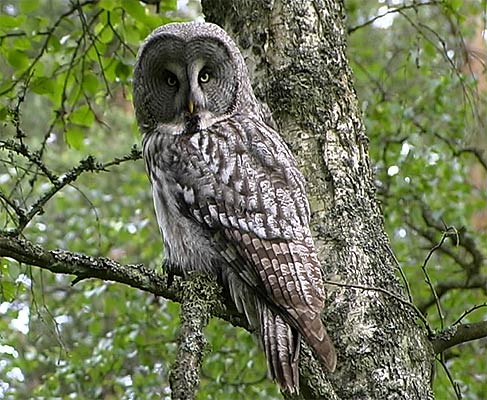Nomdeploom (talk | contribs) m (Eliminate Linnaeus taxonomy (Opus editors' decision)) |
|||
| Line 1: | Line 1: | ||
| − | ;Strix nebulosa | + | ;[[:Category:Strix|Strix]] nebulosa |
| − | [[Image:Great_Grey_Owl.jpg|thumb|550px|right|Photo by Rob.<br/>Photo taken: Skummesslövstrand, [[Sweden]] | + | [[Image:Great_Grey_Owl.jpg|thumb|550px|right|Photo by Rob.<br />Photo taken: Skummesslövstrand, [[Sweden]]]] |
| − | |||
==Identification== | ==Identification== | ||
| − | L. 24-33" (61-84 cm) | + | *L. 24-33" (61-84 cm) |
| − | W. 5' (1.5 m) | + | *W. 5' (1.5 m) |
*Huge | *Huge | ||
*Dusky gray | *Dusky gray | ||
| Line 10: | Line 9: | ||
*Large facial disks | *Large facial disks | ||
*Distinctive black chin spot bordered by white patches (resembles a bow tie) | *Distinctive black chin spot bordered by white patches (resembles a bow tie) | ||
| + | *One of the most elusive of birds, the Great Gray was discovered in America by Europeans before they realized that the species also occurs in Europe. | ||
====Similar Species==== | ====Similar Species==== | ||
[[Barred Owl]] and [[Spotted Owl]] are smaller, stockier, and browner, with dark eyes. | [[Barred Owl]] and [[Spotted Owl]] are smaller, stockier, and browner, with dark eyes. | ||
| Line 15: | Line 15: | ||
Resident from Alaska and across interior Canada south to northern California, northern Wyoming, Minnesota, and Quebec. In winter wanders rarely southward into northern New England and Great Lakes region. Also in Eurasia. | Resident from Alaska and across interior Canada south to northern California, northern Wyoming, Minnesota, and Quebec. In winter wanders rarely southward into northern New England and Great Lakes region. Also in Eurasia. | ||
==Taxonomy== | ==Taxonomy== | ||
| − | |||
==Habitat== | ==Habitat== | ||
Coniferous forests and muskeg | Coniferous forests and muskeg | ||
==Behaviour== | ==Behaviour== | ||
Like other owls of the Far North, this species hunts during the day, often watching for prey from a low perch. Because it spends much of its time in dense conifers, it is often overlooked. | Like other owls of the Far North, this species hunts during the day, often watching for prey from a low perch. Because it spends much of its time in dense conifers, it is often overlooked. | ||
| − | |||
| − | |||
| − | |||
| − | |||
==External Links== | ==External Links== | ||
{{GSearch|Strix+nebulosa}} | {{GSearch|Strix+nebulosa}} | ||
| − | [[Category:Birds]] | + | [[Category:Birds]][[Category:Strix]] |
Revision as of 18:31, 25 October 2008
- Strix nebulosa
Identification
- L. 24-33" (61-84 cm)
- W. 5' (1.5 m)
- Huge
- Dusky gray
- Yellow eyes
- Large facial disks
- Distinctive black chin spot bordered by white patches (resembles a bow tie)
- One of the most elusive of birds, the Great Gray was discovered in America by Europeans before they realized that the species also occurs in Europe.
Similar Species
Barred Owl and Spotted Owl are smaller, stockier, and browner, with dark eyes.
Distribution
Resident from Alaska and across interior Canada south to northern California, northern Wyoming, Minnesota, and Quebec. In winter wanders rarely southward into northern New England and Great Lakes region. Also in Eurasia.
Taxonomy
Habitat
Coniferous forests and muskeg
Behaviour
Like other owls of the Far North, this species hunts during the day, often watching for prey from a low perch. Because it spends much of its time in dense conifers, it is often overlooked.




